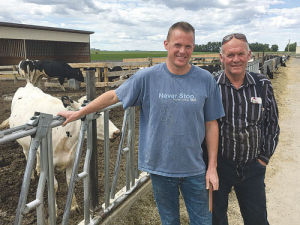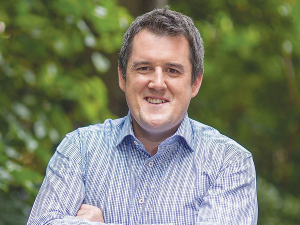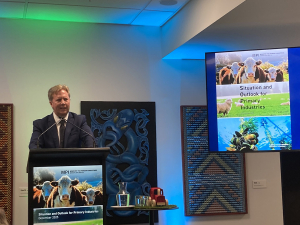However, he fine-tuned the process, adding a third milking for 84 high production cows from his herd of 150 head.
Alex moved from Holland with his mother and father, Adrian and Bertha, at the age of 15 in 1994, and now manages the family farm, near Lethbridge in southern Alberta, Canada. He hosted an Alltech tour of Australian and New Zealand dairy farmers in May.
Alex milks 145-150 cows, all housed due to winter temperatures that can drop to -35oC and colder. Milking high-producing cows three times a day has yieleded an extra 1000kg of milk – up to 11,400kg – over 305 milking days.
Under the system, first milking begins at 3am, the high-production group is milked again at 10.30am and the final milking is at 4.30pm, with the low group milked first, followed by the high group.
The herd was averaging 38kg of milk at 3.85% fat. Although Huisman said the format was working really well, he started milking the entire herd three times a day last month because of heat stress.
“The high group was too big so I have split the herd up evenly,” he said. “They are averaging 40.5kg at 3.75% fat. The drop in fat percentage was caused by heat stress.”
Huisman’s father was dairying in Holland with his brother and father.
There are many rules there, he said. He chose to move to southern Alberta because of the big open areas, the slightly lower cost of land there than in the provinces of Ontario and British Colombia, and advice that forage harvested in Alberta was of a higher quality.
The warmer conditions in southern Alberta are better for irrigated pastures and cropping, whereas further north winter may persist for six months of the year.
Huisman aims to be as self-sufficient as possible. On their 210ha farm, which is irrigated, they grow 22ha grass, 50ha alfalfa silage, and crop 66ha of canola for cash crop. They also grow 52ha of corn which they chop.
They employ two full-time and two part-time staff, enabling them to take on contract work, including field work and manure handling. For five years they worked to improve their infrastructure.
With cows housed all year, they run a total mixed ration system, feeding a mix of 500 grams of dry grass (grass hay), 2.8kg of alfalfa hay, 17.5kg of corn silage, 7kg of grass silage, 1kg of alfalfa baleage and 12kg of concentrate.
“We add 10kg of water to get the concentrate to stick to the silage better.”
It boils down to about 25kg of DM intake per cow per day. They purchased their own hammer mill early last year.
“With a hammer mill you get better processing than rollers, which you have to adjust a lot depending on what barley and corn you get. We get a more consistent mix now.”
All grain is purchased, selected by bushel weight and cleanliness.
“We reject it if there are too many wild oats. Ergot has also been a problem lately in barley and wheat. It’s horrible stuff and can cause pregnancy failure, depending on percentage.”
The Huismans have improved animal and operator comfort by improving the dairy and cow barns.
They initially milked 45 cows through a double-five parallel parlour but now have a double-12 parallel parlour, house their cows in a 152-freestall barn and a second barn with a special needs pen and dedicated areas for calvers and calves.
“We used to have calves outside, but it could get to -30oC with wind chill. If a calf was born outside you’d better be there because it’s too cold for them.”
An ABS mating system is used to select new genetics, with an emphasis on milk, fat and longevity. Sexed semen is used for heifers.
Their 21-day pregnancy rate (eligible cows divided by pregnancies) is 22-25%, well above the Alberta average of 15-16%. Heifers are first joined at 13-14 months.
Pre-calving cows are brought to a calving barn three weeks before calving. They get a ration of straw (1.8kg), corn silage (15kg) and 5kg of close-up ration including Optigen.
Alltech products Optigen, Yea-Sacc and Bioplex/Selplex are used for lactation cows. The Bioplex and Selplex products provide a 100% replacement of all inorganic trace minerals in the diet.
Yea-Sacc is a specifically selected live yeast strain, which Alltech says is proven to enhance digestibility and performance in dairy cows; Bioplex and Sel-Plex are organically bound trace minerals.
Optigen (called Optisync in Australia) is a non-protein nitrogen (NPN) source that enables improved feed conversion through the provision of nitrogen for the rumen microbes. Optisync drip feeds nitrogen consistently over the whole day, which Alltech says helps better diet utilisation, rumen health and fermentation.
Alex allows cows to lick their calves dry before removing them. Cows are then moved to the free stall barn.
Calves are weaned off milk and onto water, home grown feed that Huisman grinds himself and a calf starter. He does not like feeding meal to calves. At 10 weeks, calves receive grain and meal, which he also prepares himself.
















